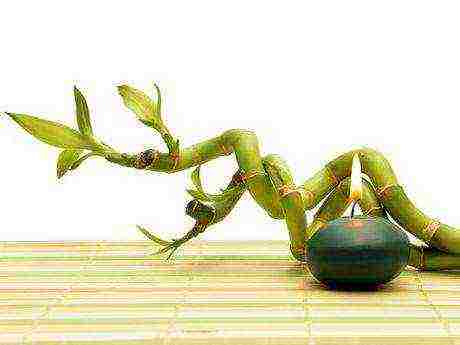Content
- 1 Fine chrysanthemums (cultivation and care)
- 2 How to grow chrysanthemums from seeds on your site?
- 3 Growing chrysanthemums from seeds using seedlings
- 4 Cutting and dividing the chrysanthemum bush
- 5 Lush blooms on a staggering scale
- 6 What to look for when buying
- 7 Wintering is most important
- 8 Light mode for potted chrysanthemums
- 9 Temperature regimes
- 10 Watering for potted chrysanthemums
- 11 Air humidity
- 12 Top dressing for pot stars
- 13 Pruning and shaping bushes
- 14 Potted chrysanthemum breeding methods:
- 15 Common problems and diseases:
- 16 Potted chrysanthemums are used for:
- 17 Care
- 18 Growing chrysanthemums at home video
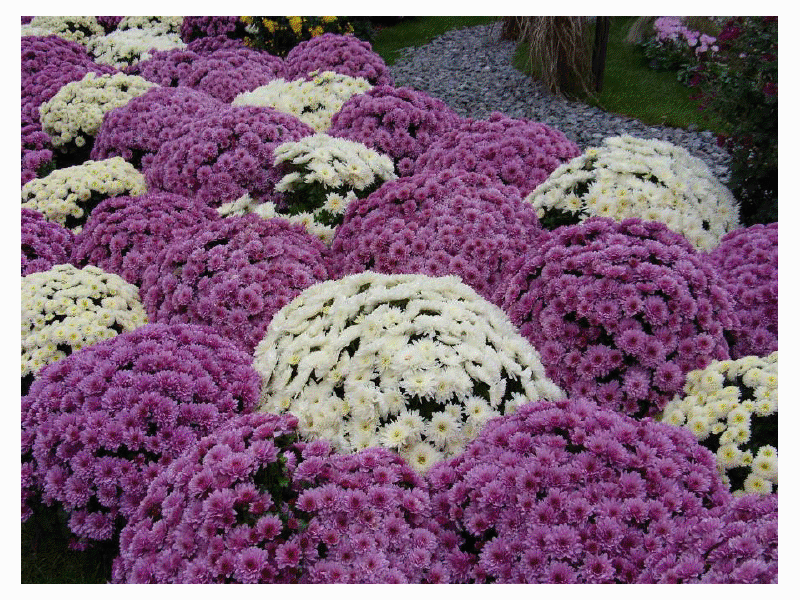
For cultivation on the site, two varieties are used: ground chrysanthemum and Korean.
Chrysanthemum belongs to the Asteraceae family. The flowering period lasts from September to October. Leaves are sessile, green with a gray tinge, erect stems.
The height of the shrub can vary from 30 to 110 cm. The larger the shrub, the more flowers are formed on it, under favorable conditions it can grow up to 100 inflorescences with a double or semi-double surface. The rhizomes of the plant are branched, with root shoots, penetrate into the soil to a depth of 25 cm.
The inflorescence of the chrysanthemum is a basket, it contains a large number of individual flowers.
The diameter of the inflorescence ranges on average from 5 to 10 cm. The shape of the flowers can be varied: flat, pompous, anemone. The color has a wide palette, the petals can be lilac, orange, crimson, pink, red, white, orange. A pleasant light aroma emanates from the flowers.
Chrysanthemums are planted in group plantings, combining shrubs with flowers of different shades. Chrysanthemums complement those trees that change the color of their foliage with the change of season. You can also do group plantings with other perennial herbaceous plants or shrubs.
The most common types that are grown on sites:
- The crowned chrysanthemum has a simple stem, the height reaches 70 cm, although it may be less. Basal leaves do not stay on the plant for a long time. Inflorescences are single or collected in groups. Leaves of this type can be used for food.
- Chrysanthemum alpine low-growing plant, average height 15 cm. Leaves are collected in a rosette, single baskets, 3 cm in diameter. The flowering period lasts from July to August. This variety looks great on alpine slides, it is also grown in pots, borders.
- Chrysanthemum keeled is an annual species, it grows from 20 to 70 cm. The stem is erect, fleshy, the leaves are also dense. Inflorescences can be double and semi-double, have a pronounced aroma. The flowering period lasts from June to September, the flowering is abundant.
- Shrub chrysanthemum is a tall species, reaching 1 meter. Inflorescences are large, reach 5 cm in diameter, double or semi-double, can be located singly or in groups of 2-10 pieces. Flowers are tubular or ligulate.
- Chrysanthemum mulberry (Chinese) - bred artificially, this is a low-growing plant whose height ranges from 30 to 130 cm. The shoots are erect, lignify over time. Inflorescences can be simple, semi-double or double, reach an average of 6 cm in diameter, emit a pleasant light aroma.
- Korean chrysanthemums originated in a hybrid way. Flowers can reach a diameter of 15 cm, the maximum height of the shrub is 1 meter.
Hybrid varieties are easier to tolerate bad weather and temperature changes. They are less likely to encounter diseases and pests, and are distinguished by a long flowering period.
Growing chrysanthemums from seeds
Growing chrysanthemums from seeds does not require much time and special conditions. The plant is not whimsical and adapts well to environmental conditions. Not all types of chrysanthemums are grown from seeds, only some annual species, as well as Korean small-flowered representatives, are suitable. Other types of chrysanthemums can be obtained only by dividing the bush or by cuttings.
Sowing seeds of annual chrysanthemums can be done directly in open ground.
This is done in mid-May. Flowering occurs only in autumn, but if you want to see flowers as quickly as possible, then seedlings are planted, it quickly adapts to open ground and environmental conditions. The seeds of perennial chrysanthemums are sown at the end of January. If the winter turned out to be cold, then you can wait another month and sow chrysanthemums in February. The development of seedlings is slow, so if you plant a flower in the spring or later, then flowering will come only next year.
Soil for sowing seeds needs light, you can prepare it according to the following scheme:
- 1 part sand
- 1 part humus
- 2 pieces of leafy land
Expanded clay, gravel or other material that acts as drainage must be placed on the bottom of the seedling container. The seeds of annual species are planted to a depth of no more than 1 cm. If the chrysanthemum is Korean, then the seeds are laid out on the surface. The sprouts will appear in about 2 weeks; under favorable conditions, the period may be reduced.
While the seedlings are in containers, the ambient temperature should be within 18 degrees. The soil must be constantly moist, for this it is periodically sprayed from a spray bottle, preventing it from drying out. The water for spraying is warm and settled. When several full-fledged leaves appear, the plants dive into separate containers.
Seedlings are transplanted into open ground in early June, and if the weather permits, then a little earlier.
An open, sunny place is chosen on the site. Groundwater should not pass close to the surface, chrysanthemums do not like stagnant water. The soil should be light and fertile. In the fall, chrysanthemums are dug up and stored until spring in a cool room. This is done only in the first year while the plants have not yet matured. Further, no shelter is required for the winter, especially if the winter is mild.
Planting chrysanthemums in open ground
It is very easy to grow chrysanthemums outdoors, but this does not mean that it does not require special conditions:
- The most important thing is to choose a sunny area.
- In addition, the plant should not be affected by wind and drafts, so it is advisable that the flowers be blocked by a fence or a house.
- For chrysanthemums, you need to find a flat area. This is due to the spring period, if the flowers are planted in the lowlands, that is, there is a great risk that during the melting of the snow, the water will drain and flood the plants. The same goes for rainy weather, a large amount of water can lead to the death of plants.
- The ideal option for chrysanthemums is a place near hedges, it will let light through for flowers and protect from bad weather.
The flowering period of most varieties falls in the fall, so the light regime should be as natural as possible. If you make changes, then the petals of the flower can change their structure, the stem becomes less durable, the decorative effect of the flower is significantly reduced.
If there is not enough sun for the flower, only flower buds will form. If the daylight hours are increased, then axillary buds, leaves and stems will be laid. That is, for the normal life of a plant, it needs an ordinary daylight hours so that all processes go on as usual.
If it is necessary for the chrysanthemum to bloom a little earlier, then during the formation of buds, the plant is covered from the sun. Then flowering can start 2 weeks earlier.
The Korean variety is the most hardy among the rest.
After winter, it begins to actively develop at temperatures from 2 degrees Celsius. If autumn began early and the first frosts fell during the flowering period, then this is not a big deal, the chrysanthemum is able to withstand temperatures down to -10 degrees. If during the autumn frosts the plant froze, then after a while it can thaw and continue to bloom.
Chrysanthemum tolerates heat harder than cold. On summer days, generative organs are laid, so the plant may underdevelop. In open ground, chrysanthemums are planted at the very beginning of summer or at the end of May. You need to focus on the temperature of the soil, it should have time to warm up to 14 degrees, you need to check the temperature at a depth of at least 20 cm.
Watering chrysanthemums:
- Be sure to water the plants after planting, it is especially important to do this in July.
- If there is a lack of moisture, especially in sunny, dry weather, flower buds may not form. It is from them that inflorescences will grow in the future.
- If the soil does not have time to dry out due to the large amount of precipitation, then there is no need to water the plant.
- With an excess of moisture, the plant will not feel bad, but the more juicy the shoots are, the greater the risk that they will freeze during autumn frosts.
Do not forget to moisten the soil in the first weeks after planting seedlings or cuttings that have not yet been rooted. The soil should be fertile, preferably loamy, with an acidity of 6.5. Loamy soil retains heat well and can protect the flower during cold weather.
To grow chrysanthemums on sandy soil, peat and humus will need to be added to it during digging. If the plants get into the garden of their greenhouse, then it is better to store them indoors for the winter as well.
Planting indoor chrysanthemums
Chrysanthemums are often grown indoors. In order for chrysanthemums not only to actively develop, but also to bloom in a pot, it is necessary to select good soil.
You can purchase a special composition in the store, or you can cook it yourself, for this, the following components are used:
- Garden arable land
- Coarse sand
- Granular peat
- Bone flour
If you take a bucket of soil, then bone meal will need a small pot, about 7 cm in size. The pot is not completely filled with compost, 1/3 of the container is not poured. A sprout is placed in the mixture. It is installed so that the roots are on the surface, after which the remaining compost is filled up. You do not need to press down firmly on the ground after planting, so as not to damage the roots. Also, several plants should not be close to each other.
At the initial stage of cultivation, the soil is moistened with a spray bottle, it should not have time to dry out.
The sprouts must immediately be provided with bright sunlight. The optimum temperature at night is up to 10 degrees Celsius. Within a month, the root system should completely fill the pot. After that, the young plant is transplanted into a larger pot. For adult plants, a slightly different soil composition will be required, it will include the following components:
- 1 part sand
- 1 part peat
- 3 parts garden soil
- 0.5 parts dry manure
- Handful of bone meal
Watering is carried out the day before the chrysanthemum is transplanted into a new pot and immediately after. Until the stems of the plant have grown stronger, they will need support. It is not necessary to repot the plant anymore, only if the roots have made their way to the surface of the earth.
Chrysanthemums are not only able to decorate any interior. They are prized for the ability to grow them for cutting. For the latter, annual species are used, in particular keeled chrysanthemum. In order for potted chrysanthemums to develop more actively, various stimulating biological products can be used. They activate the growth of dormant buds, after which the crown becomes denser, and more buds are formed.
The following drugs are used:
- Planta Miracle-Growth
- Bud
- Epin
- Zircon
It has been experimentally proven that the use of a light solution of potassium humate leads to an acceleration of plant development, an increase in the volume of the root system, an increase in the size of buds and the general decorative effect of plants.
Reproduction, caring for chrysanthemums and possible problems
Chrysanthemums can be propagated in several ways:
- Rhizome division
- By cuttings
Each method has its own characteristics, advantages and disadvantages. The division of the bush is done immediately after winter. You need to have time to do this before young shoots appear. In the evening, the shrub is dug out of the ground, and the rhizome is divided into several parts. These parts are treated with a solution of potassium permanganate and planted on the site.
The plot is chosen sunny, a distance of 50 cm is kept between the shrubs. Watering is carried out in a thin stream right at the root. In autumn, a part of the shrubbery bends over and is buried in the ground. To keep the branch well, staples are used. In the spring, a new shoot with its own root system will begin to grow from this place. In May, the soil is harvested and a new shoot is cut off. It can be left in the same place or transplanted to a new one.
The easiest way to propagate chrysanthemum by cuttings. In addition, it is guaranteed that you will get the same beautiful bush as an adult. The procedure is carried out in the spring and summer.
Chrysanthemum cuttings:
- After the threat of frost has passed and the ground has thawed at a depth of 30 cm, suitable mother bushes are selected, the life of which is more than 1 year.
- Flowers can be fed before breeding.
- When the ambient temperature reaches +18 degrees, you can see that new shoots with matte leaves appear on the shrub. These shoots will be used for propagation and are pruned when they are no more than 25 cm in length.
- In order for rooting to take place successfully, a plot of land with rich loosened soil is prepared, shading is done.
- There should be a distance of 20 cm between the cuttings.
The first month you need to carefully monitor the soil moisture, otherwise the roots will not form. At first it may seem that the cuttings are withering, but when the root system is formed, they will come to life and begin to actively grow.
Young chrysanthemums need feeding every 2 weeks, if the weather is unfavorable or the soil is poor, then fertilization can be applied every week.
If a large number of buds or peduncles have formed, then it is advisable to remove the smallest and weakest ones. Then the rest will be largest and brighter.
The most common diseases and pests of chrysanthemums:
- Gray rot
- Powdery mildew
- Leaf rust
- Root bacterial cancer
- Leaf spot
- Aphid
- Meadow bug
- Chrysanthemum nematode
Most of the problems arise from improper care of the chrysanthemum, in particular, insufficient or excessive watering. High humidity can lead to diseases.
Chrysanthemum is an unpretentious plant, however, certain conditions must be observed to obtain a lush shrub. Nutritious soil and bright light are the main factors for large, bright flowers.
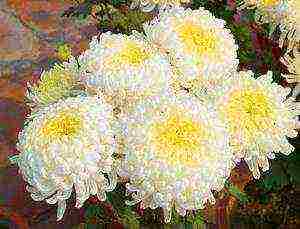 Chrysanthemums are one of the favorite plants of flower growers. This is due not only to their beautiful decorative appearance, but also to their relatively easy care. They decorate any flower garden until late autumn.
Chrysanthemums are one of the favorite plants of flower growers. This is due not only to their beautiful decorative appearance, but also to their relatively easy care. They decorate any flower garden until late autumn.
Fine chrysanthemums (cultivation and care)
Growing chrysanthemums is not difficult even for inexperienced gardeners. Well-lit areas with fertile soil of average texture are suitable for them. The soil should not contain excess organic fertilizers. When choosing a place for chrysanthemums, remember that they do not tolerate stagnant water. This plant is distinguished by its cold resistance and drought resistance.
Chrysanthemums reproduce by cuttings and division of mother liquors. Recently, the method of growing these flowers by sowing seeds in open ground and for seedlings has become increasingly used.Most often, this breeding method is used for breeding rare varieties of chrysanthemums. Some experienced florists grow flowers by sowing seeds before winter.
Chrysanthemums are considered quite resistant plants to diseases and pests, but despite this, they can be affected by:
- Powdery mildew, a sign of which is a white powdery coating on all parts of the plant. This disease requires the introduction of a sufficient amount of phosphorus and potassium fertilizers, regular removal of old leaves and root watering without moisture entering the leaves.
- Nematodosis, in which light spots appear on the leaves, limited by veins. Then they turn black and dry. Control methods: soil treatment with steam, disinfection with formalin or carbothion. Sick bushes are kept in hot water (55 ° C) for 5 minutes. After this treatment, they are planted in disinfected soil.
- A field or meadow bug that feeds on plant juices. Control methods: spraying with various insecticides (Karbofos, Decis, Fury).
- A spider mite that damages the leaves from the underside. Control methods: spraying with "Karbofos".
The following forms of chrysanthemums are grown in flower beds:
- Small-flowered, which have many shoots, crowned with numerous (up to 800 pcs.) Small inflorescences, 2-9 cm in diameter.
- Large-flowered, reaching a height of 1-1.2 meters. On their stems there are 1-10 large inflorescences.
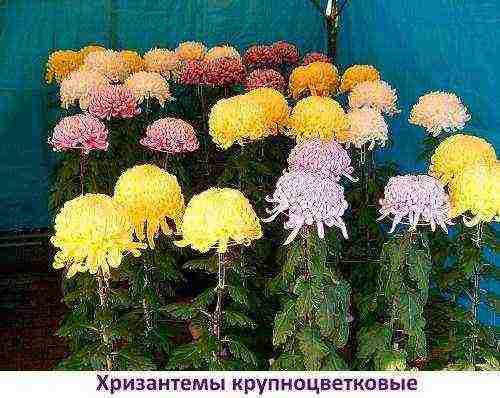
Some growers use the biological characteristics of certain varieties of chrysanthemums to grow them in the winter under indoor conditions. To obtain flowering plants in January-March, late-flowering varieties with a budding period of 12-14 weeks are used. This method of growing chrysanthemums is very costly as it uses additional lighting.
How to grow chrysanthemums from seeds on your site?
The cultivation of annual and perennial chrysanthemums has recently become more and more popular. They can be obtained by sowing seeds in open ground at the end of April or in May. On the prepared beds, holes are made with an interval of 20-25 cm. Fill them with warm water and put 2-3 seeds each. The holes covered with earth are covered with a vegetable film. Thanks to it, the soil in the hole will be well warmed up and moistened, which contributes to the fastest germination of seeds.

 When the first shoots appear, the shelter is removed. Caring for young chrysanthemums consists in regularly loosening the soil, removing weeds and applying additional fertilizing. A week after germination, they can be fed with liquid fertilizer, highly diluted with water. For this, preparations such as "Rainbow" and "Ideal" are suitable.
When the first shoots appear, the shelter is removed. Caring for young chrysanthemums consists in regularly loosening the soil, removing weeds and applying additional fertilizing. A week after germination, they can be fed with liquid fertilizer, highly diluted with water. For this, preparations such as "Rainbow" and "Ideal" are suitable.
When the seedlings reach 5-10 cm in height, one plant is left in the hole. For this, the strongest specimens are chosen. The rest of the seedlings can be carefully removed from the ground and planted elsewhere. Chrysanthemums bloom 40-50 days after the seedlings appear.
Growing chrysanthemums from seeds using seedlings
Growing chrysanthemums from seeds can also be done through seedlings. At the same time, flowering occurs much faster. Perennial chrysanthemums are grown only in this way. In February-March, seeds are sown in small boxes filled with nutritious soil. For its preparation, in equal proportions, you can take soil from a greenhouse, humus and peat. Before sowing the seeds, the soil mixture is sieved and steamed at a temperature of about 120 ° C. Ready-made soil for flowering plants is also suitable for seedlings.
Drainage must be poured at the bottom of the boxes (expanded clay, small stones, broken red brick). Wet soil is poured on top of it. Seeds are poured onto its surface.
At the same time, there is a strict rule for their termination:
- the seeds of annual chrysanthemums are sprinkled with a layer of soil of 0.5 cm;
- seeds of perennial varieties are left on the surface of the soil, only by pressing them with the palm of your hand.
The earth is moistened with a spray bottle. The boxes are covered with plastic wrap.They are placed in a warm place where the temperature is 23-25 ° C. Crops are regularly checked, moistened and aired. The soil should not dry out. Shoots appear after 10-14 days. After that, the boxes with seedlings are placed in a bright place.
When 2-4 leaves appear, the plants dive into cups or pots. This will protect the chrysanthemum root system from damage during transplantation. Seedlings that are very elongated and weakened are not suitable for diving. After completing this procedure, the plants are sprayed with a solution of "Zircon" or "Epin-Extra". These drugs help the seedlings take root faster.
Caring for young chrysanthemums is simple. It consists in maintaining an optimal temperature of 16-18 ° C, regular watering and feeding. Plants are fertilized once every 2 weeks. If there is insufficient natural light, you may need additional. With proper care, seedlings reach 15-20 cm in height in 1.5 months. When the air outside warms up to 15-18 ° C, the plants are transferred to the greenhouse. After the end of the threat of spring frosts in May, chrysanthemums are planted in a permanent place. Immediately after landing on the flower beds, the tops of the seedlings are pinched. When the lateral shoots reach a length of 15-20 cm, the pinching is repeated. Thanks to this procedure, dense, compact bushes are obtained, strewn with numerous inflorescences.
Cutting and dividing the chrysanthemum bush
The main way of reproduction of chrysanthemums is considered vegetative - cuttings. The breeding process begins with the selection of the best mother plants. After flowering, they are dropped in greenhouses or planted in boxes and left in a cool, dry place with normal lighting. Then vernalization is carried out - the content of mother liquors at a temperature of 1-4 ° C for 2-4 weeks. Then they are brought into a warm, well-lit room. After that, root shoots begin to grow actively on the mother liquors. It is cut into cuttings when 2-3 internodes are formed. They are planted in prepared boxes. The optimum temperature for their development is 16-18 ° C.
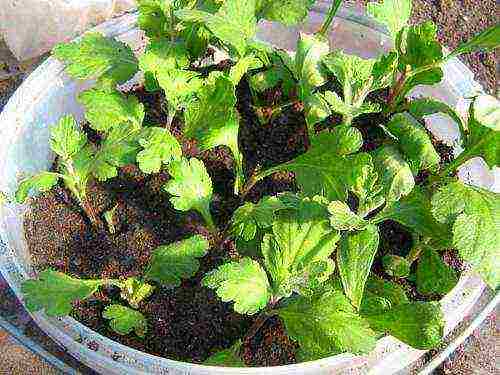
Reproduction by dividing the bush is less productive, but the easiest. Small-flowered chrysanthemums are most often used for division. The bushes are transplanted after 2 years, dividing them into several parts with young shoots.
Growing chrysanthemums at home (video)
It is impossible not to succumb to the charm of potted chrysanthemums. Huge "sheaves" or balls, covered with so many flowers that seem almost like pillows on the eve of autumn, flood the markets and flower shops. A more popular and common seasonal pot is not found. Chrysanthemums are used to decorate gardens and terraces, facades and front gardens, balconies and apartments. All potted chrysanthemums have one thing in common - low winter hardiness. She determines the specifics of the cultivation of the main autumn soloists.
Lush blooms on a staggering scale
Chrysanthemums are so popular at the end of the season not only because the color palette perfectly represents the so-called autumn palette. The colors of the chrysanthemum flowers really perfectly emphasize the crimson-fiery autumn range. But no color nuances can overshadow the main thing - relentless and very long flowering, unique in its scale and abundance. In addition, potted chrysanthemums are very diverse in varietal colors.
Potted chrysanthemums that cannot withstand winter frosts can be grown in two forms:
- Seasonal indoor or balcony annual;
- A perennial that is taken indoors for the winter and cut off after a dormant period, stimulating growth.
Potted chrysanthemums can also be planted in open soil - but then they will need to be dug up and transferred to pots for the winter. Therefore, they are more often grown in container culture.
Chrysanthemums in container form are different from their garden counterparts.They develop in the form of dense cushion-shaped bushes, formed by pruning and bred specifically to obtain specimens of increased density. Numerous shoots are woody, dotted with simple carved leaves, which most often do not create a particularly impressive crown, but only serve as a background for flowers. They bloom at the tops of the shoots in such numbers that they create solid caps.
Classic inflorescences-baskets in potted chrysanthemums are both simple and densely double, with wider or very narrow reed petals. And the color, which includes all the warm shades of white-cream, yellow, orange, red, purple, brown palette, can be both monochromatic and combined and even contrasting.
New in fashion today blue-colored chrysanthemums and original green-colored plants, as well as varieties with dazzling acrylic colors. Even more popular are large-flowered varieties - hybrids with spherical, pompom, anemone-shaped inflorescences, which adorn gardens during all warm months, and bloom in indoor culture all autumn and winter.
Potted chrysanthemums are different in size. For indoor culture and indoor cultivation choose mini-varieties, the height of which does not exceed 30 cm. But the intended for open air specimens are twice as large, sometimes reaching 1 meter in height and diameter. Potted chrysanthemums are standard, and formed in the form of a ball, and squat, and even sloping. In short, there is plenty to choose from. Moreover, indoor chrysanthemums are sold in bloom throughout the year, and garden chrysanthemums today appear on the shelves in spring, and are specially driven out at atypical times. But such early maturing plants are just a temporary decoration of both the house and the garden, which will have to be thrown away. If you want to preserve chrysanthemums, buy them during their typical flowering times, from late summer to autumn. When buying, be sure to specify exactly what conditions the chrysanthemums are accustomed to and how they need to be grown: sometimes chrysanthemums of local distillation require specific care.
In order for potted chrysanthemums to bloom truly profusely, they will need simple, but constant care and rather specific conditions. They bloom luxuriantly at low temperatures, and this requirement can be ignored only when grown as an annual or by a callout in fresh air. Watering and feeding are frequent, but other than them, no difficulties with chrysanthemums usually arise.
What to look for when buying
Chrysanthemums in the markets are presented in such a quantity that it is not easy to choose a single bush. But try to be very careful, because success directly depends on how picky you are. Never buy chrysanthemums with fully blooming inflorescences - specimens in which inflorescences have bloomed no more than half will bloom better and longer. The bushes should be fully formed, strong, the shoots should be woody from the bottom, and the leaves should be healthy. Please note that yellowing of foliage, spots on leaves and shoots are unacceptable.
Wintering is most important
Chrysanthemums develop cyclically, with a period of complete rest. It is the difficulty of wintering that makes many people simply throw away the plants after flowering is complete. If you have the opportunity to provide the necessary conditions, do not rush to doom the plant to death.
If you want to keep your beautiful chrysanthemum in a pot and admire its flowering from year to year, then you will have to take care of proper wintering. Both indoor miniature and real garden potted chrysanthemums should winter in the same way (in many respects, this is why they are not divided into separate groups). The dormant period begins immediately after flowering.The bushes need to be mercilessly cut to short stumps and immediately transferred to the coldest room in which the temperature does not drop below 0, but will be as close as possible - from 2 to 5 degrees Celsius, ideally.
At this time, chrysanthemums are hardly watered or fed, leaving them alone until the first signs of spilling appear. As soon as the chrysanthemums begin to grow, they are immediately transferred to a cool place and into a bright light, transplanted into a new pot or replace the substrate and begin to water and feed.
But that's not all: in order for the chrysanthemum to bloom as abundantly next year, it is desirable that it be in cool conditions and at the stage of flowering. If the plant is in a hot room, it will not bloom profusely.
Light mode for potted chrysanthemums
Chrysanthemums are crops for which a short daylight hours are enough for abundant flowering. But this does not mean at all that they are content with shaded locations. Throughout the entire period of active development, including flowering, chrysanthemums need to be provided with the sunniest and brightest locations where plants will not suffer from midday rays or will be shaded from them by neighboring potted plants. In winter, chrysanthemums are kept in dark rooms (with the exception of specimens that continue to bloom, which are transferred to the lightest locations of the rooms and plan to be thrown away after flowering)
Temperature regimes
Potted chrysanthemums (both garden and indoor) love coolness, especially during the flowering stage. These are not the most heat-resistant crops that are comfortable only in typical autumn conditions. The higher the air temperature, the faster the inflorescences fade and the less chrysanthemums produce new buds. That is why even miniature indoor plants are best kept outdoors during flowering. The optimal temperature regime for potted chrysanthemums is from 10-15 to 17-20 degrees Celsius or a little more. If chrysanthemums are in temperatures above 21-22 degrees during the flowering period, they will not be able to normally lay buds for flowering next year, and even cold wintering will not give the expected effect.
Watering for potted chrysanthemums
Autumn beauties need regular and fairly frequent watering. They do not like excess moisture, but they cannot stand drought either. To achieve optimal moisture, immediately after the procedure, you need to drain excess water from the pallets, and let the top layer of soil dry before the next watering.
Air humidity
Frequent watering is fully compensated by the absence of the need to humidify the air. To make the plant bloom more beautifully, and the foliage to be more attractive and thick, chrysanthemums can be sprayed periodically. But at the same time, droplets of moisture should not accumulate on the buds and inflorescences, and even more so they should not get very wet. The exception is chrysanthemums blooming in the rooms in winter, which need to compensate for the operation of central heating systems.
Top dressing for pot stars
For such an abundant flowering, chrysanthemums need access to nutrients in very large quantities. The soil and the plant itself is severely depleted, so these plants are fed in fact as garden annuals - very often. It is better to reduce the dose of fertilizers, but feed them themselves every 1-2 weeks. When signs of flowering end, be sure to slowly reduce the number of dressings. Stop fertilizing before wintering out. Feeding is resumed 2 weeks after transplantation.
For chrysanthemums, it is better to use special fertilizer mixtures or universal mixtures for flowering plants. If you use regular fertilizers, then during the formation of the bush, apply more nitrogen, and with the appearance of buds, more potassium and phosphorus.
Pruning and shaping bushes
For potted chrysanthemums, not one, but several scraps are needed:
- removal of wilting inflorescences that need to be removed from the bushes as quickly as possible;
- pinching the tops to form a dense and compact crown, which is carried out in spring and early summer 2-3 times;
- if desired, limit the height of the bushes or stimulate the second wave of flowering in winter - restraining pruning by 1/3 of the shoots;
- pruning before wintering, which is carried out to small stumps, removing all aerial parts.
Substrate for potted chrysanthemums: any soil mixture with a loose texture, admixture of sand and transfer (except sour).
Transplant time: perennial chrysanthemums are transplanted annually, old bushes - every two years immediately after signs of growth appear in the spring. Drainage is laid at the bottom of the tanks, the level of deepening is kept the same.
Potted chrysanthemum breeding methods:
- Seeds that germinate well, but require many years of growing seedlings and a very long wait for flowering.
- Separation of bushes, which is carried out on old chrysanthemums in the spring or after flowering.
- By cuttings in spring or summer. Apical cuttings root both in the ground and in water, they require planting 2-3 copies in one pot and pruning at first to 10-15 cm, and then in the form of constant pinching as they grow to form a crown.
Common problems and diseases:
- various rot, quickly spreading when the inflorescences get wet and waterlogged;
- absence or poor flowering due to temperature disturbances and poor feeding.
Control methods: care correction
Potted chrysanthemums
Potted chrysanthemums are used for:
- interior decoration, accent and color spot in the autumn-winter setting of the house;
- a spectacular guardian plant at the gate, front door, on the bends of the path;
- to create interiors of terraces and recreation areas in the fall;
- for decorating autumn flower beds and ridges, masking voids and introducing beautifully flowering accents into boring corners of the garden;
- in still lifes and decorative groups to decorate resting places in the garden;
- for the decoration of balconies and verandas.
Chrysanthemums adore decor and fanciful containers, love the company of other potted plants and do not get lost even in the most colorful collection.
Chrysanthemums of modern varieties amaze with the abundance of flowering and the richness of the color of inflorescences. When the nature of the middle lane is already preparing for winter, chrysanthemums are just beginning to delight flower growers with bright colors of unfolding inflorescences. Not surprisingly, many plant lovers purchase compact potted chrysanthemums to grow in their homes.
Care
Temperature.
Chrysanthemum is a short day plant and prefers lower temperatures. Of course, it will grow and bloom at normal room temperature, but it will develop much better and bloom longer, the chrysanthemum will be at a temperature of 10-15 degrees. The maximum temperature for keeping chrysanthemums is 18 degrees. At a higher temperature, the buds may dry out, the leaves may turn yellow, the inflorescences fade very quickly. This is especially true for newly purchased plants that are not adapted to home conditions. Chrysanthemums grown by you from the cuttings and "brought up" at home are more resistant to high temperatures.
A bright and cool window is the best place to keep a chrysanthemum in the house.
Lighting.
The home chrysanthemum is a light-loving flower, but as mentioned above, it needs a short daylight hours, within 8 hours. Shading is required from direct sunlight.
Chrysanthemums like that at the end of summer and autumn, the temperature drops significantly, and daylight hours decrease significantly. The beginning of flowering of chrysanthemums occurs exactly at the moment when the length of the day becomes no more than 8 hours.
Watering and humidity.
Chrysanthemum roots do not tolerate dryness of the soil. Therefore, maintain a light moisture content of the substrate, overdrying the soil is harmful.Flower growers growing potted chrysanthemums should remember to water these plants moderately. The chrysanthemum flower does not impose special conditions on the humidity of the air, but spraying and bathing will not harm it. During the flowering period, be sure to feed your home chrysanthemum with flowering fertilizer every week.
Transfer.
The frequency of transplanting for chrysanthemums is the same as for most indoor plants - young annually, adults after a year. In principle, she is indifferent to the composition of the earth. The only condition is that the earth should not be acidic. Therefore, for transplanting potted chrysanthemums, you can safely use ordinary garden soil. But if you add humus, peat and leafy earth to it in equal proportions, then the mixture will turn out to be looser and more nutritious.
Leaving after flowering.
After the chrysanthemum has faded, cut it back and allow for a cold winter. The optimum temperature for chrysanthemums during the dormant period is + 2-3 degrees. The best place for such wintering is the cellar. At the beginning of spring, when the shoots start to grow, it is advisable to transplant it into fresh soil (for the young - a must!). When the plant develops normally, young cuttings can be cut from it for propagation.
Features of cultivation.
To give the chrysanthemum bush a more luxuriant look, it must be pinched and cut off. Moreover, this must be done during the entire period of active growth of the plant. If you do not cut it or limit yourself to spring pruning, the plant will turn out to be elongated and unattractive. To prolong the flowering of chrysanthemums, try to remove faded flowers in time and remove yellowed leaves.
With the onset of stable heat, it is highly desirable to take out the chrysanthemum in a pot to fresh air. Moreover, many gardeners plant it in open ground, where it grows before the onset of cold weather (following the example of geranium), after which it, together with a lump of earth, is transplanted into a pot and it continues its flowering in the house. By the way, the same can be done with a garden chrysanthemum, of course, if you have enough space to keep it.
If the chrysanthemum has formed a lot of buds, and you need it to bloom faster, remove some of the ovaries. This technique will speed up the onset of flowering of the plant, and the opened inflorescences will be larger.

Growing chrysanthemums at home video

